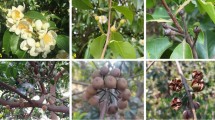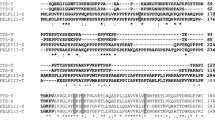Abstract
Pollen–pistil interactions are thought to involve a wide variety of intercellular recognition events controlled by diverse proteins and other molecules. One of the best characterized interactions is the S-RNase-based gametophytic self-incompatibility (GSI) system found in Solanaceae, Rosaceae and Scrophulariaceae. Although the S specificity of the pistil and the pollen in these families is determined by the S locus-encoded proteins S-RNase and SLF/SFB, respectively, these proteins alone are not sufficient for operation of the GSI reaction. Other factors are also required and are classified into three groups. To date, the only known factor is the pistil-expressed small asparagine-rich protein HT-B in three solanaceous genera Nicotiana, Lycopersicon and Solanum. HT-B is a Group 2 factor that is required for pollen rejection but do not affect S-RNase expression; factors in the other groups have not yet cloned. Here, we identified a new class of HT-like proteins in the style of Petunia inflata and named it HTL. Through alternative splicing, it was found that two isolated homologous HTL cDNAs, HTL-A and HTL-B, derived from a single gene. Like HT-B, HTL showed pistil-specific accumulation as well as significant sequence similarity to HT including conserved cystein residues at the C-terminal region and a signal peptide for extracellular localization. However, unlike HT-B, HTL lacked an asparagine-rich domain. Thus, it represents a new class of HT proteins. To determine whether HTL is involved in GSI function, RNA silencing constructs for HTL-A and HTL-B were introduced into self-incompatible P. inflata. Although several transgenic lines showed no detectable levels of both HTL-A and HTL-B transcripts, they retained normal GSI function and produced large fruits upon compatible pollination. This suggests that since silencing of the HTL gene alone is not sufficient to affect reproductive physiology, the gene is functionally distinct from the GSI factor HT-B.





Similar content being viewed by others
References
Ai Y, Singh A, Coleman CE, Ioerger TR, Kheyr-Pour A, Kao T-H (1990) Self-incompatibility in Petunia inflata: isolation and characterization of cDNAs encoding three S-allele-associated proteins. Sex Plant Reprod 3:130–138
Ai Y, Kron E, Kao T-H (1991) S-alleles are retained and expressed in a self-compatible cultivar of Petunia hybrida. Mol Gen Genet 230:353–358
Anderson MA, Cornish EC, Mau S-L et al (1986) Cloning of cDNA for a style glycoprotein associated with expression of self-incompatibility in Nicotiana alata. Nature 321:38–44
Atkinson AH, Heath RL, Simpson RJ, Clarke AE, Anderson MA (1993) Proteinase inhibitors in Nicotiana alata stigmas are derived from a precursor protein which is processed into five homologous inhibitors. Plant Cell 5(2):203–213
Bernatzky R, Glaven RH, Rivers BA (1995) S-related protein can be recombined with self-compatibility in interspecific derivatives of Lycopersicon (tomato). Biochem Genet 33:215–225
Bradford M (1976) A rapid and sensitive method for quantitation of microgram quantities of protein utilizing the principle of protein-dye binding. Anal Biochem 72:248–254
Broothaerts W, Janssens GA, Proost P, Broekaert WF (1995) cDNA cloning and molecular analysis of two self-incompatibility alleles from apple. Plant Mol Biol 27:499–511
Cruz-Garcia F, Hancock N, Kim D, McClure B (2005) Stylar glycoproteins bind to S-RNase in vitro. Plant J 42:295–304
de Nettancourt D (2001) Incompatibility and incongruity in wild and cultivated plants. Springer, Berlin Heidelberg New York
Doyle JJ, Doyle JL (1990) Isolation of plant DNA from fresh tissue. Focus 12:13–15
Entani T, Iwano M, Shiba H, Che F-S, Isogai A, Takayama S (2003) Comparative analysis of the self-incompatibility (S-) locus region of Prunus mume: identification of a pollen expressed F-box gene with allelic diversity. Genes Cells 8:203–213
Frohman MA, Dush MK, Martin GR (1988) Rapid production of full-length cDNAs from rare transcripts: amplification using single gene-specific oligonucleotide primer. Proc Natl Acad Sci USA 85:8998–9002
Gleave AP (1992) A versatile binary vector system with a T-DNA organisational structure conductive to efficient integration of cloned DNA into the plant genome. Plant Mol Biol 20:1203–1207
Horsch RB, Fry JE, Hoffmann NL, Eichholtz D, Rogers SG, Fraley RT (1985) A simple and general method for transferring genes into plants. Science 227:1229–1231
Hosaka K, Hannemen RE (1998a) Genetics of self-compatibility in a self-incompatible wild diploid potato species Solanum chacoense. 1. Detection of an S locus inhibitor (Sli) gene. Euphytica 99:191–197
Hosaka K, Hannemen RE (1998b) Genetics of self-compatibility in a self-incompatible wild diploid potato species Solanum chacoense. 2. Localization of an S locus inhibitor (Sli) gene on the potato genome using DNA markers. Euphytica 103:265–271
Hugot K, Ponchet M, Marais A, Ricci P, Galiana E (2002) A tobacco S-like RNase inhibits hyphal elongation of plant pathogens. Mol Plant Microbe Interact 15:243–250
Kondo K, Yamamoto M, Itahashi R, Sato T, Egashira H, Hattori T, Kowyama Y (2002a) Insights into the evolution of self-incompatibility in Lycopersicon from a study of stylar factors. Plant J 30:143–154
Kondo K, Yamamoto M, Matton DP, Sato T, Hirai M, Norioka S, Hattori T, Kowyama Y (2002b) Cultivated tomato has defects in both S-RNase and HT genes required for stylar function of self-incompatibility. Plant J 29:627–636
Lai Z, Ma W, Han B, Liang L, Zhang Y, Hong G, Xue Y (2002) An F-box gene linked to the self-incompatibility (S) locus of Antirrhinum is expressed specifically in pollen and tapetum. Plant Mol Biol 50:29–42
Lee H-S, Singh A, Kao T-H (1992) RNase X2, a pistil-specific ribonuclease from Petunia inflata, shares sequence similarity with solanaceous S proteins. Plant Mol Biol 20:1131–1141
Lee H-S, Huang S, Kao T-H (1994) S proteins control rejection of incompatible pollen in Petunia inflata. Nature 367:560–563
McClure BA, Haring V, Ebert PR, Anderson MA, Simpson RJ, Sakiyama F, Clarke AE (1989) Style self-incompatibility products of Nicotiana alata are ribonucleases. Nature 342:955–957
McClure BA, Gray JE, Anderson MA, Clarke AE (1990) Self-incompatibility in Nicotiana alata involves degradation of pollen rRNA. Nature 347:757–760
McClure B, Mou B, Canevascini S, Bernatzky R (1999) A small asparagine -rich protein required for S-allele-specific pollen rejection in Nicotiana. Proc Natl Acad Sci USA 96:13548–13553
McClure BA, Cruz-Garcia F, Beecher BS, Sulaman W (2000) Factors affecting inter- and intra-specific pollen rejection in Nicotiana. Ann Bot 85:113–123
McCubbin AG, Kao T-H (2000) Molecular recognition and response in pollen and pistil interactions. Annu Rev Cell Dev Biol 16:333–364
Murfett J, Atherton TL, Mou B, Gasser CS, McClure BA (1994) S-RNase expressed in transgenic Nicotiana causes S-allele-specific pollen rejection. Nature 367:563–566
Nielsen H, Engelbrecht J, Brunak S, von Heijne G (1997) Identification of prokaryotic and eukaryotic signal peptides and prediction of their cleavage sites. Protein Eng 10:1–6
O’Brien M, Kapfer C, Major G, Laurin M, Bertrand C, Kondo K, Kowyama Y, Matton DP (2002) Molecular analysis of the stylar-expressed Solanum chacoense small asparagine-rich protein family related to the HT modifier of gametophytic self-incompatibility in Nicotiana. Plant J 32:985–996
Olmstead RG, Sweere JA, Spangler RE, Bohs L, Palmer JD (1999) Phylogenetic and provisional classification of the Solanaceae based on chloroplast DNA. In: Nee M, Symon DE, Lester PN, Jessop JP (eds) Solanaceae IV. Royal Botanic Gardens, Kew, pp 111–137
Qiao H, Wang H, Zhao L, Zhou J, Huang J, Zhang Y, Xue Y (2004) The F-box protein AhSLF-S2 physically interacts with S-RNases that may be inhibited by the ubiquitin/26S proteasome pathway of protein degradation during compatible pollination in Antirrhinum. Plant Cell 16:571–581
Saitou N, Nei M (1987) The neighbor-joining method: a new method for reconstructing phylogenetic trees. Mol Biol Evol 4:406–425
Sassa H, Hirano H (1998) Style-specific and developmentally regulated accumulation of a glycosylated thaumatin/PR 5-like protein in Japanese pear (Pyrus serotina Rehd.). Planta 205:514 521
Sassa H, Hirano H, Ikehashi H (1992) Self-incompatibility-related RNases in styles of Japanese pear (Pyrus serotina Rehd.). Plant Cell Physiol 33:811–814
Sassa H, Nishio T, Kowyama Y, Hirano H, Koba T, Ikehashi H (1996) Self-incompatibility (S) alleles of the Rosaceae encode members of a distinct class of the T2/S-ribonuclease superfamily. Mol Gen Genet 250:547–557
Sassa H, Hirano H, Nishio T, Koba T (1997) Style-specific self-compatible mutation caused by deletion of the S-RNase gene in Japanese pear (Pyrus serotina). Plant J 12:223–227
Schägger H, von Jagow G (1987) Tricine-sodium dodecyl sulfate-polyacrylamide gel electrophoresis for the separation of proteins in the range from 1 to 100 kDa. Anal Biochem 166:368–379
Sessa G, Fluhr R (1995) The expression of an abundunt transmitting tract-specific endoglucanase (Sp41) is promoter-dependent and not essential for the reproductive physiology of tobacco. Plant Mol Biol 29:969–982
Sijacic P, Wang X, Skirpan AL, Wang Y, Dowd PE, McCubbin AG, Huang S, Kao T-H (2004) Identification of the pollen determinant of S-RNase-mediated self-incompatibility. Nature 429:302–305
Singh A, Ai Y, Kao T-H (1991) Characterization of ribonuclease activity of three S-allele-associated proteins of Petunia inflata. Plant Physiol 96:61–68
Sonneveld T, Tobutt KR, Vaughan SP, Robbins T (2005) Loss of pollen-S function in two self-compatible selections of Prunus avium is associated with deletion/mutation of an S haplotype-specific F-box gene. Plant Cell 17:37–51
Thompson JD, Gibson TJ, Plewniak F, Jeanmougin F, Higgins DG (1997) The clustal X windows interface: flexible strategies for multiple sequence alignment aided by quality analysis tools. Nucleic Acids Res 25:4876–4882
Ushijima K, Sassa H, Tamura M, Kusaba M, Tao R, Gradziel TM, Dandekar AM, Hirano H (2001) Characterization of the S-locus region of almond (Prunus dulcis): analysis of a somaclonal mutant and a cosmid contig for an S haplotype. Genetics 158:379–386
Ushijima K, Sassa H, Dandekar AM, Gradziel TM, Tao R, Hirano H (2003) Structural and transcriptional analysis of the self-incompatibility locus of almond: identification of a pollen-expressed F-box gene with haplotype-specific polymorphism. Plant Cell 15:771–781
Ushijima K, Yamane H, Watari A, Kakehi E, Ikeda K, Hauck NR, Iezzoni AF, Tao R (2004) The S haplotype-specific F-box protein gene, SFB, is defective in self-compatible haplotypes of Prunus avium and P. mume. Plant J 39:573–586
van Engelen FA, Molthoff JW, Conner AJ, Nap J-P, Pereira A, Stiekema WJ (1995) pBINPLUS: an improved plant transformation vector based on pBIN19. Transgenic Res 4:288–290
Wesley SV, Helliwell CA, Smith NA, Wang MB, Rouse DT, Liu Q, Gooding PS, Singh SP, Abbott D, Stoutjesdijk PA, Robinson SP, Gleave AP, Green AG, Waterhouse PM (2001) Construct design for efficient, effective and high-throughput gene silencing in plants. Plant J 27:581–590
Xue Y, Carpenter R, Dickinson H, Coen ES (1996) Origin of allelic diversity in Antirrhinum S locus RNases. Plant Cell 8:805–814
Yamane H, Ikeda K, Ushijima K, Sassa H, Tao R (2003) A pollen-expressed gene for a novel protein with an F-box motif that is very tightly linked to a gene for S-RNase in two species of cherry, Prunus cerasus and P. avium. Plant Cell Physiol 44:764–769
Acknowledegments
We thank Dr. J.B. Power for P. inflata seeds, Dr. P.M. Waterhouse for pHANNIBAL, Dr. A.P. Gleave for pART27 and Dr. W.J. Stiekema for pBINPLUS. Drs. Y. Ogawa, Y. Hoshino and H. Washida are acknowledged for their technical advice. We also thank Melody Kroll for proof reading this manuscript. This work was supported in part by the Grants-in-Aid for Scientific Research (C, 13660011) and the Grants-in-Aid for Young Scientists (A, 16688001) from the Ministry of Education, Science, Sports and Culture of Japan to H.S.
Author information
Authors and Affiliations
Corresponding author
Additional information
Communicated by G. Jürgens
Rights and permissions
About this article
Cite this article
Sassa, H., Hirano, H. Identification of a new class of pistil-specific proteins of Petunia inflata that is structurally similar to, but functionally distinct from, the self-incompatibility factor HT. Mol Genet Genomics 275, 97–104 (2006). https://doi.org/10.1007/s00438-005-0067-7
Received:
Accepted:
Published:
Issue Date:
DOI: https://doi.org/10.1007/s00438-005-0067-7




